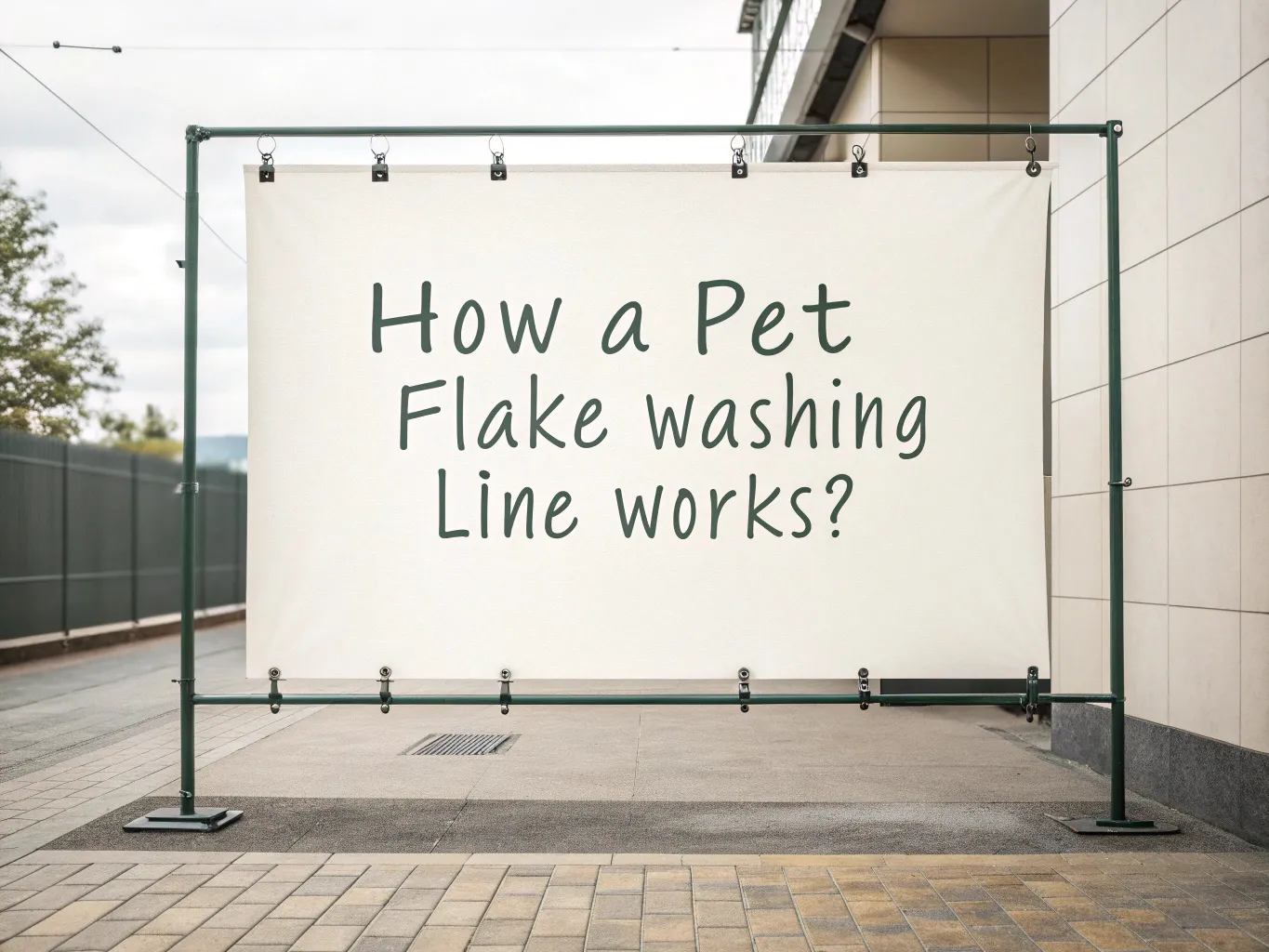V době, kdy je udržitelnost prvořadá, se recyklace polyethylentereftalátu (PET) stala klíčovou součástí nakládání s odpady. PET, který se nachází ve všem od lahví na nápoje až po obaly na potraviny, je vysoce recyklovatelný – ale pouze pokud je správně zpracován. Práce na PET vločkách je místem, kde se děje zázrak, kdy se špinavý, vyřazený plast přemění na nedotčené vločky připravené k opětovnému použití.
Pro ty, kteří se zabývají recyklací – ať už jako majitelé firem, inženýři nebo environmentálně uvědomělí jedinci – je nezbytné pochopit, jak každý kus zařízení přispívá k tomuto procesu. Pojďme se blíže podívat na stroje, které to vše umožňují.
Proč jsou linky na praní PET vloček nezbytné
Recyklovaný PET je velmi žádaný, ale použité lahve se dodávají kontaminované nečistotami, etiketami, lepidlem a zbytky. Bez důkladného čištění tyto nečistoty činí materiál nevhodným pro opětovné použití. Prací linka tyto kontaminanty systematicky odstraňuje a zajišťuje, že konečný produkt splňuje průmyslové standardy pro výrobu nových lahví, textilií nebo obalů.
Každý stroj v lince má svou specifickou roli a spolupracuje na maximalizaci efektivity a kvality výstupu.
Základní komponenty linky na praní PET vloček
1. Drtič balíků – Uvolnění nákladu
Proces začíná těsně sbalenými balíky sesbíraných PET lahví. Drtič balíků tyto slisované svazky rozebere a oddělí jednotlivé lahve ke zpracování.
- Účel: Rozděluje balíky pro snadnější manipulaci.
- Funkce: Používá mechanickou sílu k jemnému oddělení lahví bez poškození.
- Klíčové zvážení: Robustní lis na balíky minimalizuje ruční zásahy a zajišťuje plynulý chod linky.
2. Dopravní pás – Udržujeme věci v pohybu
Jakmile jsou lahve uvolněny z balíku, dopravníkový pás je přepravuje mezi jednotlivými fázemi. Tento nepřetržitý pohyb je nezbytný pro udržení efektivity pracovního postupu.
- Účel: Bezproblémově přesouvá materiál z jednoho stroje na druhý.
- Funkce: Nastavitelná rychlost pomáhá přizpůsobit rychlost zpracování linky.
- Klíčové zvážení: Trvanlivost je klíčová – zvolte vysoce kvalitní řemeny, abyste zkrátili prostoje z důvodu údržby.
3. Odstraňovač štítků – Odstranění nežádoucích štítků
Štítky a lepidla je nutné odstranit včas, aby se zabránilo kontaminaci.
- Účel: Odlepuje papírové nebo plastové štítky.
- Funkce: K jejich odloupnutí se používá tření, proudění vzduchu nebo mechanické škrabky.
- Klíčové zvážení: Efektivní odstraňování etiket zlepšuje čistotu vloček, zejména pro recyklaci v potravinářské kvalitě.
4. Drtič/Shredder – Drcení lahví na vločky
Celé lahve se pro snazší mytí drtí na malé, rovnoměrné vločky.
- Účel: Redukuje PET na zvládnutelné fragmenty.
- Funkce: Vysokorychlostní čepele řežou lahve, často s vodou, aby se minimalizoval prach.
- Klíčové zvážení: Nastavitelné nastavení čepelí zajišťuje konzistentní velikost vloček a zlepšuje tak účinnost mytí.
5. Předmycí nádrž – První čištění
Před hloubkovým čištěním se vločky předběžně opláchnou, aby se odstranily uvolněné nečistoty a nečistoty.
- Účel: Odstraňuje povrchové nečistoty.
- Funkce: Rozvířená voda uvolňuje nečistoty a zbytky tekutin.
- Klíčové zvážení: Tento krok chrání následné zařízení před abrazivními částicemi.
6. Plovoucí nádrž – separace podle hustoty
Ne všechny plasty jsou PET – víčka a kroužky (často polypropylenové) je nutné odstranit.
- Účel: Izoluje PET od lehčích plastů.
- Funkce: PET klesá, zatímco ostatní materiály plavou a sbírají se.
- Klíčové zvážení: Přesnost je zde zásadní pro vysoce čistý výstup.
7. Horká mycí nádrž – řešení odolných zbytků
Teplo a čisticí prostředky rozkládají oleje, lepidla a další odolné nečistoty.
- Účel: Hloubkově čistí a sterilizuje vločky.
- Funkce: Horká voda (někdy s louhem sodným) rozpouští zbytky.
- Klíčové zvážení: Regulace teploty zabraňuje degradaci PET.
8. Třecí podložka – mechanický drhák
Vysokorychlostní míchání zajišťuje odstranění veškerých zbývajících nečistot.
- Účel: Zlepšuje čistotu vloček.
- Funkce: Roztočí vločky ve vodě a pomocí tření odstraní nečistoty.
- Klíčové zvážení: Zlepšuje průhlednost, zejména u transparentního PET.
9. Oplachovací nádrž – Závěrečné mytí
Zajišťuje, aby nezůstaly žádné čisticí prostředky ani uvolněné nečistoty.
- Účel: Zajišťuje důkladné závěrečné opláchnutí.
- Funkce: Čistá voda odstraňuje všechny přetrvávající částice.
- Klíčové zvážení: Vícestupňové oplachování zlepšuje čistotu.
10. Odstředivá sušička – odstraňování vlhkosti
Mokré vločky se odstředí vysokou rychlostí, aby se odstranila přebytečná voda.
- Účel: Snižuje obsah vlhkosti.
- Funkce: Rychlá rotace mechanicky vytlačuje vodu.
- Klíčové zvážení: Energeticky úsporné ve srovnání s tepelným sušením.
11. Horkovzdušný sušič – zaručuje dokonale suché vločky
Pro aplikace vyžadující extrémně nízkou vlhkost dokončí práci horký vzduch.
- Účel: Odstraňuje zbytkovou vlhkost.
- Funkce: Ohřátý vzduch odpařuje zbývající vodu.
- Klíčové zvážení: Funguje nejlépe v kombinaci s odstředivým sušením.
12. Silo/Balicí systém – připraveno k prodeji
Konečný produkt je skladován nebo balen k prodeji.
- Účel: Skladuje a připravuje vločky k distribuci.
- Funkce: Automatizované systémy plní pytle nebo sila pro manipulaci s hromadným materiálem.
- Klíčové zvážení: Zjednodušené balení zlepšuje provozní efektivitu.
Praní studenou vs. horkou vodou: Která je lepší?
- Praní ve studené vodě: Používá vodu z okolního prostředí, šetří energii, ale je méně účinný na odolné zbytky. Vhodný pro PET nižší kvality (např. vlákna).
- Horké praní: Důkladnější odstraňování olejů a lepidel – ideální pro PET potravinářské kvality.
Volba závisí na zamýšleném použití recyklovaného materiálu.
Optimalizace vaší prací linky
- Pravidelná údržba: Zabraňuje poruchám a zajišťuje konzistentní kvalitu.
- Recyklace vody: Snižuje náklady a dopad na životní prostředí.
- Kontroly kvality: Testujte vločky v kritických fázích, abyste včas odhalili kontaminaci.
- Vlastní nastavení: Upravte drcení, mytí a sušení tak, aby vyhovovalo vašim vstupním surovinám.
Sečteno a podtrženo: Udržitelnost se setkává se ziskovostí
Dobře fungující linka na praní PET vloček nejen prospívá planetě, ale je také rozumnou investicí do podnikání. Vysoce kvalitní recyklovaný PET dosahuje prémiových cen a zároveň snižuje závislost na panenském plastu.
Od lámání balíků až po finální sušení hraje každý stroj klíčovou roli v přeměně odpadu na cenný zdroj. Pro ty, kteří pracují v tomto odvětví, znamená zvládnutí tohoto procesu přispět k oběhovému hospodářství – jednu čistou vločku po druhé.



